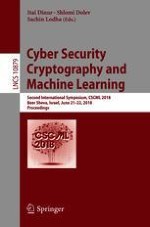2018 | OriginalPaper | Buchkapitel
An Information-Flow Control Model for Online Social Networks Based on User-Attribute Credibility and Connection-Strength Factors
verfasst von : Ehud Gudes, Nadav Voloch
Erschienen in: Cyber Security Cryptography and Machine Learning
Aktivieren Sie unsere intelligente Suche, um passende Fachinhalte oder Patente zu finden.
Wählen Sie Textabschnitte aus um mit Künstlicher Intelligenz passenden Patente zu finden. powered by
Markieren Sie Textabschnitte, um KI-gestützt weitere passende Inhalte zu finden. powered by
